This mornings catch off the back deck. Took me three hours to process. Who says LABs don’t work? – From Rick Schnurr, MV Julie May, Canoe Cove




This mornings catch off the back deck. Took me three hours to process. Who says LABs don’t work? – From Rick Schnurr, MV Julie May, Canoe Cove



October, 2014
Dear Member:
Please plan to attend the Annual General Meeting (AGM) of the BC Nautical Residents Association. It is scheduled for Sunday, November 16th, 4:00pm, at the Stonehouse Pub, located at 2215 Canoe Cove Rd, North Saanich, BC V8L 3X9. Please plan to stay for a ‘no host’ dinner after adjournment of the meeting. The food is great and the pub is a relaxing environment in which to get acquainted with your fellow nautical residents!
Please RSVP your attendance and dinner reservation by responding to our broadcast email or via our contact form.
If you are unable to attend the meeting in person, please complete and return the Proxy Vote Form by November 2nd. You can mail it to: BC Nautical Residents Association, 309 – 1521 Church Avenue, Victoria, BC V8P 5T7, email it (scan your signed form and respond to the broadcast email), or fax it to 250-479-4192. Thank you.
A new Board of Directors (5 – 7 members) will be elected at the AGM. If you are interested in serving, please be prepared to let your name stand at the meeting. All board candidates will be asked to introduce themselves before the election. No long political speeches are required! You’ll have two minutes maximum to introduce yourself, including where you’re from, the skills and experience you would bring to the organization, and why you’re interested in serving on the BCNRA Board of Directors.
If you can’t attend the AGM, and want to run for the Board, email your introduction by November 2nd and confirm that you would be able to attend monthly directors’ meetings in person or by Skype.
If you have an item that you would like discussed at the AGM, please email it to us through our contact form by November 2nd to ensure that you’ll have time on the agenda.
Looking forward to seeing you at the BCNRA AGM!
Donna Sassaman
Recording Secretary
BC Nautical Residents Association
Whether you can make it to the AGM or not, we’d like to hear from you! Please take the time to complete this short survey prior to the 2014 AGM. This will help the directors to continue moving forward in supporting marine communities on the BC Coast. You can either respond to this email or complete the online form.
Online Form: https://bcnr.org/current-events/2014-member-survey/
Date ________________
Name _______________
1. What do you believe to be the biggest challenges for marine communities in your area or on the BC coast?
2. In the last few years have you noticed any positive changes in marine communities?
3. Are there any areas where you feel the BCNRA isn’t doing enough?
4. Would you be willing to volunteer or fund projects for the benefit of all marine communities?
5. What else would you say to the directors of the BCNRA?
Rick, Tim and Kris attended the Harbour Dialogue Open House and Ideas Forum put on by the City of Victoria this past weekend. We were interested to hear the ideas and to ensure that marine communities were considered as the city works to improve the inner harbour. For more information and an opportunity to share your ideas in a survey, follow the link below.
http://www.victoria.ca/EN/main/departments/planning-development/community-planning/harbour-dialogue.html



By: Rick Schnurr, MV Julie May, Victoria Harbour
Over the past couple of months there have been two boat fires in Puget Sound marinas. Enough is enough! These fires are a great concern to all boaters, live aboards included. One fire on one boat can and often does lead to many boats in the marina being affected. This was certainly the case last weekend in La Conner, Washington, where 15 boats were damaged in the most recent fire.
The cause of the La Conner fire is not know at this time.
But, I want to weigh in with my own prejudice about using electric heaters on boats during the winter months. There are usually two groups of boaters using electric heaters. One group are the live aboard boaters, who, by definition, are aboard their boats and thus, monitoring the heater. The second group are those boaters who do not live aboard and are not monitoring the boat on a daily basis. This is the group that concerns me the most because if a problem is developing, no one is aware of it until flames and smoke are billowing from the boat. At this point all other boats in the marina are also in danger. If there are no live aboard boaters in the marina or if they are grouped in only one area, then there is even less of a chance that someone else will notice the problem as it is developing.
Now, my own personal prejudice concerning electric heaters is directed towards the type of heater employed. I am dead set against any type of electric heater that uses a glowing hot coil and fan to disperse the heat. Often these are known as QUARTZ HEATERS and FAN HEATERS. Both of these types of heaters employ an extremely hot coil and anything at all flammable that comes in contact with this heater is going to catch fire. Here are pictures of this type of heater:
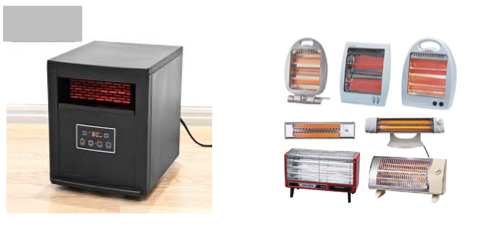
These type of heaters are often chosen because they are inexpensive and it is possible to distribute a number of them around the boat. Also, remember that these heaters often draw 1500 watts of power. If your boat is plugged into 30 amps of shore power, then each one of these will be consuming half of your shore power. Two heaters will have your shore power cord pumping at max consumption (and heat) eventually frying the cord ends (if you’re lucky). If you’re not lucky they may result in a fire on the boat.
Boats that are left unattended for long periods of time over the winter are the most susceptible to problems. But, even if you are not living aboard, there is no need to put yours and everyone’s boat at risk by using QUARTZ HEATERS. There are safer ways to keep your boat warm and dry over the winter.
On Julie May we only use OIL FILLED HEATERS for warmth and dryness during the winter months. Yes, when the temperature drops below freezing we also use our diesel heater, but only when we are on board. Oil filled heaters come in a few configurations and use between 500 watts and 1500 watts (usually with three settings, 500,1000, 1500). We use two 500 watt heaters ( fore peak & galley) and one 1500 watt heater in the salon (set to 500 or 1000 watts MAX). If we are using any other electric appliances (cooking) then the salon heater is turned off. Here are pictures of oil filled heaters: a multiple setting 1500w and a 500 or 700 watt.
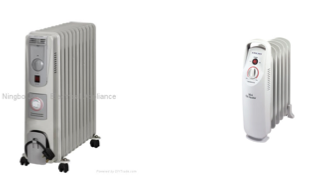
These heaters have no glowing hot coils and even if they are set too close to a bulkhead they will not burn it. I think you would have to carelessly allow something like fabric to fall over the heater to cause a problem. These oil filled heaters do a good job of keeping the boat warm and dry. They are just not as quick to heat the boat up from cold as a heater with a fan in it. While a fan/ coil heater heats the space by convection, the oil filled heater works by radiating its heat to warm the hull, bulkheads and furniture of the boat. These oil filled heaters are not much more expensive than the quartz variety. A 500 or 700 watt unit can be found for around $50.00, and a 1500 watt one will be about $80.00 to $100.00.
Here is another idea that an old salt, John Grant of Quadra Island, told me about. It is so simple. All it involves is a pie plate, a porcelain light socket, a 60watt light bulb, and a clay flower pot. Set the light socket in the pie plate with bulb installed and support a clay flower pot over it, set upside down. Turn on the light and you have a simple, safe and inexpensive heater that will keep your boat dry.
Here it is:

So for your and all of your neighbour’s safety, don’t use quartz heaters. Equip your boat with oil filled heaters (or flower pot heaters).
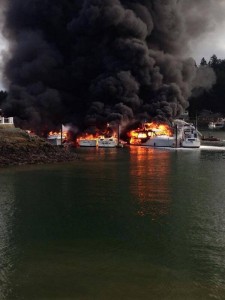 Too bad there were no LABs nearby. The fire may have been noticed sooner. Glad nobody was hurt.
Too bad there were no LABs nearby. The fire may have been noticed sooner. Glad nobody was hurt.
http://threesheetsnw.com/blog/2014/02/major-fire-engulfs-shelter-bay-marina/
I hope everyone is having a good winter/spring. I just wanted to put a small note out there to touch base with our membership as we haven’t had a chance to complete our spring newsletter. The directors have been busily working away – if you’ve kept up with our Facebook page, you’ll see there has been lots in the news. Our meeting agenda’s have been pretty full. With that said, I still want to encourage you to write us if you have some concerns or thoughts. Our next meeting is February 23rd if you’d like to submit anything. Thanks, Kris!
Re-mark your calendar for the 2013 Annual General Meeting.
Date: Sunday, November 3rd
Where: Princess Mary Restaurant, 459 Head Street, Victoria
Meeting: 3:00pm – coffee/tea; no-host dinner about 5:00 for those who want to stay and socialize over a tasty meal.
Daylight savings occurs this day so don’t forget to change your clocks or you’ll be late!
If you are interested in serving, please be prepared to let your name stand at the meeting. All board candidates will be asked to introduce themselves before the election. You’ll have two minutes maximum to introduce yourself, where you’re from, and why you’re interested in running for the BCNRA Board of Directors.
If you have an item that you would like discussed at the AGM, please send us a message through our contact form.
Hope to see you there!
 It’s that time again! On Saturday, April 20th, 2013, the Maritime Museum of BC is hosting the 10th Annual Massive Marine Garage Sale at Ogden Point – Pier A, Victoria, 9:00am – 1:00pm.
It’s that time again! On Saturday, April 20th, 2013, the Maritime Museum of BC is hosting the 10th Annual Massive Marine Garage Sale at Ogden Point – Pier A, Victoria, 9:00am – 1:00pm.
The BC Nautical Residents Association will have a table at the Garage Sale, and is soliciting donations that will help us earn some money for BCNR projects. Do you have an item or items that you’d like to donate to the cause?
Donated items should be in saleable condition: marine electronics, anchors and anchor rode, sails, cruising guides, galley gear, blocks, etc. etc.
If you live in the Greater Victoria area (Sidney to Colwood) and would like your donations to be picked up, please contact Tim Finlay at garagesale2013@bcnr.org by April 18th.
If you’re planning to attend the Garage Sale, please stop by the BCNR table to introduce yourself and have a chat!
Thank you for any items you’re able to donate to the BCNR. Hope to see you on April 20th at Ogden Point, 9:00am – 1:00pm.
By Bill Sassaman, BCNR Director
BCNR directors first heard there was a problem in Port Hardy when Globe and Mail reporter, Mark Hume, contacted Director Kris Samuels for his opinion. In his article published on October 22, 2012, Mr. Hume reported:
On September 26, the District of Port Hardy Harbour Authority served a Notice to End Moorage on Mr. [Keith] Dorward and several others who live on vessels in the small port on northern Vancouver Island.
The notice gave them 30 days to move, or “be escorted off the premises by the RCMP.”
The development is part of a movement on the West Coast, where liveaboards are slowly being forced out of urban harbours, because of concerns about pollution, unruly dockside behaviour |and unsightly boats.
David Pratt, the harbour manager in Port Hardy, declined to comment, referring all questions to Mayor Bev Parnham. But Ms. Parnham did not return calls.
Councillor Rick Marcotte didn’t want to discuss the issue either, but indicated the notice was issued because of concerns at the dock.
“Well, we are trying to clean up our harbour, actually. That’s basically it,” he said. “It’s just that there was a bunch of unemployed people with no income that are basically [living on] derelict barges … down there.”
 Kris contacted the other directors and we began an investigation into the eviction. We were put in touch with a friend of Keith Dorward, as well as an outreach worker, who both provided insights into the issues at the dock. The directors agreed to contact Mayor Parnham and Councillors with an offer to assist in mediating the issues between the Harbour Authority and the liveaboards. This offer was emailed to them on October 29th. To date, the BCNR has not received a response from the District of Port Hardy Council. Please read the letter, download a pdf version by clicking on the image to the right.
Kris contacted the other directors and we began an investigation into the eviction. We were put in touch with a friend of Keith Dorward, as well as an outreach worker, who both provided insights into the issues at the dock. The directors agreed to contact Mayor Parnham and Councillors with an offer to assist in mediating the issues between the Harbour Authority and the liveaboards. This offer was emailed to them on October 29th. To date, the BCNR has not received a response from the District of Port Hardy Council. Please read the letter, download a pdf version by clicking on the image to the right.
On November 1st Mr. Dorward and eight other liveaboards moved their boats from the District of Port Hardy’s docks. Mr. Dorward moved in with his friend on a temporary basis and, at last report, was living at the Salvation Army facility in Port Hardy. We don’t know to where the other liveaboards relocated.
Since our initial investigation, the directors have received input from other sources, who indicated that there were serious social issues at the Port Hardy dock that involved some of the liveaboards. As in all conflicts, there are a variety of perspectives. However, what is evident is that Port Hardy is only the latest in a series of efforts by marinas to rid their facilities of ‘problem’ liveaboards. Rather than dealing with individual issues, some harbour authorities have opted for policies that prohibit living aboard at their docks. BCNR’s position is that liveaboards must be responsible for their physical and social environments, and where there are problems, marina staff and liveaboard boaters need to negotiate a resolution to their specific issues.
The directors welcome your feedback on this issue. How would you approach resolving issues involving liveaboards? What has been your experience? What can we do as the BC Nautical Residents Association to prevent this type of occurrence from happening?
We want you to know that we love this life we have chosen. This means that our only permanent home is a boat. Living aboard a boat is a time honoured tradition on our coast. Sometimes we are cruising the coast of British Columbia. At other times we may be anchored in a safe harbour or tied up to a marina. One of the real pluses of our chosen lifestyle is that we can choose where we want to live, and if we decide to move, all we have to do is untie the lines or pull up the anchor and go. It’s all about freedom, a thing many talk about but fewer find.
There are other things that attract us to the life of a live aboard boater. We live in close proximity to nature. Often, our neighbours are seals, otters, mink, seagulls, Blue Herons, Kingfishers, and a variety of fish. Our human neighbours are fellow boaters from all over the world. On a marina dock, we learn to live close to each other where the skills of both being a friend and at the same time giving each other the space needed for privacy are essential. This sense of community among live aboard boaters is the memory most cherished by many of those who have moved back to shore. Living aboard a boat is also a way to simplify one’s life and have a smaller impact on the environment using less of our increasingly scarce resources. We have been able to give up the use of an automobile and rely on our feet or public transportation. Because we spend the winter docked in downtown Victoria, most of the amenities we need are either a short walk or bus ride away.
Very often we are told by people living in traditional life situations ashore, that we are living a secret dream they have had for years. Our response is always, “If you really want to do this then just go for it!” Lynn and Larry Pardey, famous world cruisers said, “Go simple and go now.” However, careful consideration is needed before making this choice; it’s not for everyone. For instance, if you are married, it is essential that you both share the same dream. (And there’s little hope for avid gardeners!)
We are writing this article because we believe that it is important for you to have an accurate account of what the live aboard life represents. Often in the media, people who live aboard and the boats they live in are presented in a negative light. A recent piece in the National Post had a large headline with the words “shanty town” and “derelict boats”. However, there were no pictures of either in the article. Many municipalities have a fear of live aboard boats due to these misconceptions, so we would like to present you with some facts to counter the prevalent myths about live aboard boats and their crews.
 Myth number one: Live aboard boaters are trying to live under the radar
Myth number one: Live aboard boaters are trying to live under the radar
Live aboard boats and the people who own them are fully in the public eye. Many marinas where they live are either open to the public or, if gated, very visible from the shoreline. Here in Victoria Harbour, the boats are a tourist attraction, with many visitors coming by, taking pictures and asking questions. The live aboard boats are a large part of the ambience of the harbour.
There are a number of families with children living aboard, and we all know, you can’t hide children. Live aboard boaters do not wish or choose to be hiding from the communities in which they live. If they are pushed into a position of feeling they have to hide, it is only due to the kind of prejudice and lack of real knowledge and understanding that so often afflicts minority communities.
Myth number two: Live aboard boaters do not pay taxes
Anyone living aboard would prefer to be securely tied up to a dock in the winter months when they are not cruising. Anchoring out in a harbour in the winter is a choice some are forced into when marina space is either not available or unaffordable. Live aboard boats rent the dock space they occupy in a marina from the marina operator. Live aboard boaters pay all municipal and provincial taxes through the moorage fees assessed by the marina in which they live, in the same manner that would be applied to anyone on shore living in rental accommodation. If one sees live aboard boats occupying an anchorage in the winter, ask if the adjacent marina offers live aboard moorage at a reasonable rate. Most often the answer is that the marina operator does not or is hampered in this by local by-laws restricting live aboard moorage. Too bad, because, as you will see below, they are giving up a lucrative revenue source. This fact becomes even more unreasonable when the same marina offers sequential moorage to people living on boats all summer long in the same location.
Myth number three: Live aboard boaters are unemployed (a reason recently given by Port Hardy city council to evict live aboard boats from the harbour)
Most live aboard boaters are either employed in the community (that’s why they need moorage adjacent to their jobs) or are retired from a work career. In my observation, most live aboard boaters are in their mid sixties and have lived aboard for more than seven years. In our community we have former military people, university professors, landscapers, retail staff, electronics engineers, mothers & fathers, computer programmers. A number of them are self employed and work from their boats, …. you get the picture.
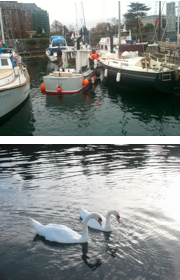 Myth number four: live aboard boaters pump their poop and other pollutants into the harbour.
Myth number four: live aboard boaters pump their poop and other pollutants into the harbour.
Federal laws prohibit the pumping of toilet waste (black water) and solvents ( oil, fuel, etc) into marine environments. Boats with marine toilets (heads) now have holding tanks for these wastes and most marinas provide services to promote clean harbour living such as holding tank pump-out, or they have shore side washroom facilities. The Greater Victoria Harbour Authority has a publicly available pump-out station located at Fisherman’s Wharf. The GVHA also provides its live aboard customers with a mobile pump out service at the boat, once a week. This service is paid for by all boaters using their facilities as a portion of their moorage fees.
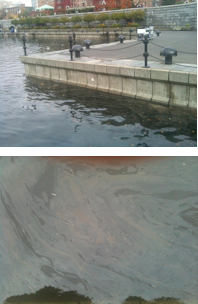 Very often, pollution in the harbour comes from shore. Oil slicks on the inner harbour water and fertilizer run off come from municipal storm drains; plastic bottles, plastic bags and coffee cups are thrown from shore. And the worst pollutant, cigarette butts, come from thoughtless smokers of all stripes.
Very often, pollution in the harbour comes from shore. Oil slicks on the inner harbour water and fertilizer run off come from municipal storm drains; plastic bottles, plastic bags and coffee cups are thrown from shore. And the worst pollutant, cigarette butts, come from thoughtless smokers of all stripes.
We live aboard boaters choose to live in this beautiful aquatic environment and none of us wants to see it polluted in any way.
Live aboard boats have a very small environmental footprint. Many occupy less that 400 square feet. They get by on 30 amps of electrical power for all lighting, heating, and cooking needs. That’s less than a homeowner on shore uses to cook dinner on an electric range. Two people living on their boat will only use about 50 gallons of fresh water in a week. We have no lawns to water. A number of us do not own automobiles and make frequent use of public transit.
Myth number five: most live aboard boats are derelict
Most live aboard boats are not derelict. Just like a house on shore, to be able to comfortably live aboard a boat, it must be maintained and kept in good condition. Also like landowners, we take pride in our homes and spend a great deal of time and money on maintenance.
Often, to be allowed to moor, insurance is required. Boat insurance is more costly than house insurance and requires rigorous regular inspections to qualify. Many boats that appear to be derelict are, in fact, not lived aboard, but are abandoned by their owners. Owners of run down boats like run down houses onshore, are an individual problem that needs to be dealt with on an individual basis. The same thing goes for anyone putting pollution into the harbour; deal with the individual committing the offence. Do not punish all for the bad behaviour of a few.
Myth number six: People living on boats are not contributing members of the community
There are almost two hundred live aboard boats in Victoria Harbour, and we are very much contributing members of our community. Our moorage and associated fees alone contribute over $1,100,000.00, to the local economy. Added to this is the money spent (locally) on groceries, clothing, maintenance, services, entertainment, education and a host of other expenses.
Live aboard boaters also contribute to the community through volunteer work, they sit on the boards of local service organizations providing community involvement, and they contribute to the economy through their jobs. One man, living on his boat in Esquimalt, is a Provincial Emergency Coordinator, providing amateur radio services during an emergency. All live aboard boaters have VHF radios on their boats and would be able to provide communication services in the event of an emergency. They are also the eyes and ears at the marinas where they live, preventing theft and damage to facilities and unattended boats. At Fisherman’s Wharf and the Causeway Docks in the inner harbour, we are tourist attractions contributing to the beautiful ambiance of Victoria Harbour. Can you imagine how many of us there are in photographs of Victoria shown around the world?
So, there you have it from our perspective, living on the water. We laugh, love and feel just like all others, and we are a part of our community. Next time you are in the harbour, stop by and say hi.
Rick Schnurr & Jude Brooks
Aboard Julie May